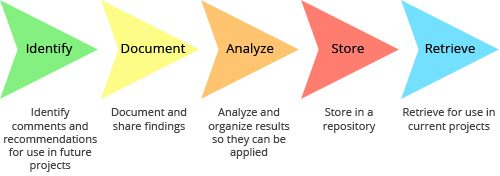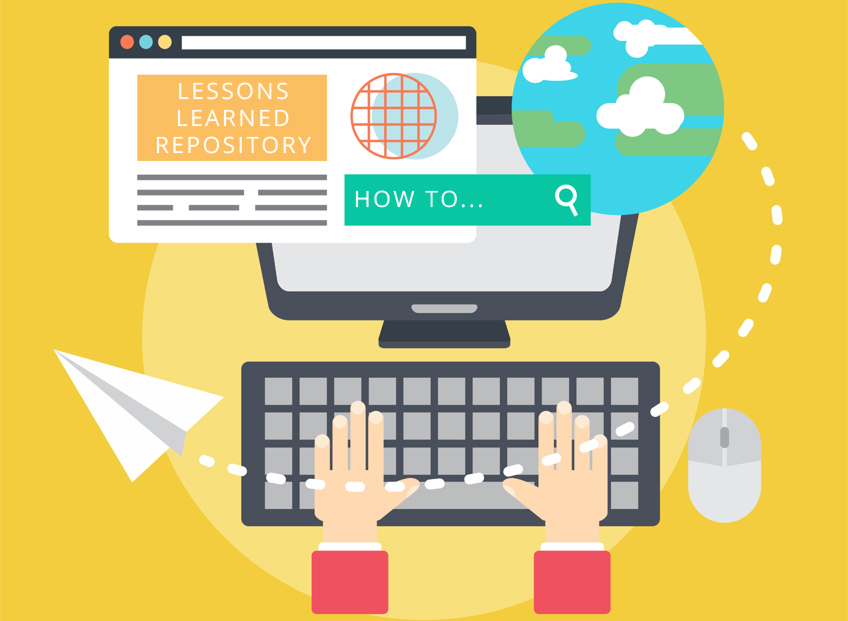Most project managers understand the importance of lessons learned on current and future projects. Capturing and regularly updating the lessons learned can keep the project on track. In the long run, it can also help continually improve how organizations execute projects.
Lessons learned definition
Lessons learned is the knowledge gained from the process of conducting a project. This includes the positives and negatives. The idea is to repeat the positives aspects and not repeat the mistakes.
The Project Management Institute’s (PMI) A Guide to the Project Management Body of Knowledge (PMBOK® Guide) defines this process as a ‘set of interrelated actions and activities performed to achieve a specified set of products, results or services’. The lessons learned process involves 5 steps with activities that will capture and use lessons learned. The steps are:

- Identify – identify the comments and recommendations that can be learned. These can be a valuable knowledge asset for future projects.
- Document – note the detailed lessons learned during discussions in a report that all participants can respond to. Distribute this report to the entire project team and retain it for future reference.
- Analyze – analyze and organize the lessons learned so they can be applied and shared with other teams. They can improve the project management or be used in training sessions.
- Store – retain the lessons learned reports on a shared drive or in a cloud solution. That makes them available to all project teams.
- Retrieve – when storing the lessons learned reports, set up a keyword search capability to make them easily retrievable at any time during and after the project.
How to document lessons learned
Without a formalized documentation process, it’s hard to keep track of any lessons learned to make adjustments and improvements. Develop an ongoing documentation process right from the kick-off meeting. Documenting lessons learned along the whole lifecycle of the project, particularly with big projects, will prevent people forgetting the lessons learned along the way.
To identify issues, carry out regular surveys during the project. You can use these surveys in quick meetings to discuss, analyze, and document the lessons learned.
Lessons learned survey template
This is just a template and project managers should develop their own questions. These surveys should be customized and updated throughout the project.
|
For each of the statements below, please indicate your level of agreement or disagreement. Project planning The project plan and schedule were well-documented, with appropriate structure and detail. (Strongly agree – Agree – Neutral – Disagree – Strongly disagree – Not applicable) Comments:____________________________ As a stakeholder, I’m happy with my level of input into the project planning process. (Strongly agree – Agree – Neutral – Disagree – Strongly disagree – Not applicable) Comments:____________________________ The project plan clearly explained the purpose of the project. (Strongly agree – Agree – Neutral – Disagree – Strongly disagree – Not applicable) Comments:____________________________ The project’s scope was well defined. (Strongly agree – Agree – Neutral – Disagree – Strongly disagree – Not applicable) Comments:____________________________ Project Execution The project schedule is on-track. (Strongly agree – Agree – Neutral – Disagree – Strongly disagree – Not applicable) Comments:____________________________ Project changes have been manageable. (Strongly agree – Agree – Neutral – Disagree – Strongly disagree – Not applicable) Comments:____________________________ I understand everyone’s responsibilities. (Strongly agree – Agree – Neutral – Disagree – Strongly disagree – Not applicable) Comments:____________________________ Sponsors have been engaged. (Strongly agree – Agree – Neutral – Disagree – Strongly disagree – Not applicable) Comments:____________________________ The project outcome is matching what’s defined in the project charter. (Strongly agree – Agree – Neutral – Disagree – Strongly disagree – Not applicable) Comments:____________________________ The project team receives a lot of interaction internally and from the facilitator. (Strongly agree – Agree – Neutral – Disagree – Strongly disagree – Not applicable) Comments:____________________________ This project environment is collaborative. (Strongly agree – Agree – Neutral – Disagree – Strongly disagree – Not applicable) Comments:____________________________ Outcome The project work is realistic and achievable. (Strongly agree – Agree – Neutral – Disagree – Strongly disagree – Not applicable) Comments:____________________________ The project’s action plan shows how our work contributes to the overall project goal. (Strongly agree – Agree – Neutral – Disagree – Strongly disagree – Not applicable) Comments:____________________________ Assignments are clearly defined. (Strongly agree – Agree – Neutral – Disagree – Strongly disagree – Not applicable) Comments:____________________________ We have strong performance metrics that help quantify success. (Strongly agree – Agree – Neutral – Disagree – Strongly disagree – Not applicable) Comments:____________________________ We’re on track to achieving the stated goal in the project charter. (Strongly agree – Agree – Neutral – Disagree – Strongly disagree – Not applicable) Comments:____________________________ My expectations of effort, time, and commitments are being met. (Strongly agree – Agree – Neutral – Disagree – Strongly disagree – Not applicable) Comments:____________________________ |
How to write lessons learned
With all the details of the lessons learned gathered and documented, you might need to edit them before adding them to the shared drive. You can create a Lessons List, which clearly summarizes the lessons learned in just a few sentences. The summaries note the lesson learned, why it was relevant and how it should be applied to future projects.
In the shared drive or wiki, the lessons should have searchable keywords attached, like “testing” or “requirements” for example. That way, project teams can search for those terms when they become relevant and always have the lessons learned available to them.
You should also produce a detailed report to team members and other stakeholders involved in the project. The type of report will depend on the audience and some lessons may have restricted access due to the nature of the information.
Overview of the lessons learned report
The detailed report should include the information gathered in the lessons learned sessions, and additional input and recommendations from participants, whether they attended or not. The report should be distributed to all participants, who get to respond. After that, it’s finalized and the project team receives a copy.
Summary – a one page brief summarizing the findings and providing recommendations.
Executive report – an overview of the lessons learned together with a summary of what went well, what went wrong, and how to improve. The detailed report can also be attached, but the executive report itself shouldn’t exceed 3 pages.
Findings – a summary of any issues found during the review process.
Recommendations – actions needed to correct or improve the findings. Any approved actions need to be documented, and then tracked to completion.
Presenting lessons learned
The project manager presents either the detailed report or the executive report, depending on the audience. The successes of the project can be shared via newsletters, white papers, presentations, and other forms of communication.
Data that’s specific to the project can go into metrics reports. It’s important to include the positive and the negative, or the metrics will be meaningless. They’re good at indicating how the project’s maturing, and can identify trends or key events. A good rule for metrics reports is to use is KIS MII – Keep It Simple; Make It Interesting.
One way to present lessons learned is via a wiki, which is easy to create. The advantage of a wiki is that any team member or stakeholder can update the lesson learned with new information as the project progresses. You can add other documentation, such as minutes from status update meetings or lessons learned review meetings. The wiki is shareable across the cloud and is a historical database of lessons learned from the project, which can be used and applied to future projects.
Applying Lessons Learned
Generally, it’s the project manager who conducts review sessions and presents lessons learned. There are 3 process groups involved – analyze, store, and retrieve.
Analyze – after lessons learned data has been gathered, conduct a root cause analysis for each lesson to better understand what to improve.
Store – documented lessons learned should be stored in a database, such as a shared drive, within a cloud-based solution, or via a wiki.
Retrieve – this is where keyword search capabilities become useful. It makes the lessons easily retrievable for project teams to review or for adding new information. It’s also useful for future projects and kick-off meetings.
Once the lessons learned are identified and documented, the organization should release the necessary resources to apply them. These can include changing a process or re-scheduling supplies. In the long run, the organization can use the lessons learned to develop a culture of ongoing improvement.


